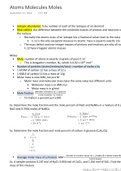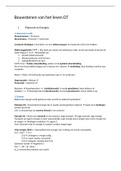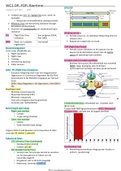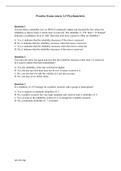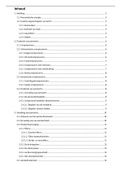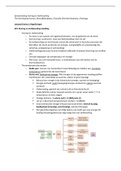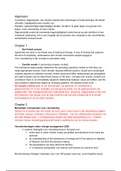Inhoudsopgave
Lecture 1 – Introduction into Economic Evaluation 2
Lecture 2 – Economic Evaluation 11
Lecture 3 – Health Outcomes in Economic Evaluations || MEASURING AND VALUING COSTS 20
Part II: Measuring and valuing costs 23
Lecture 4 – Statistical Analysis 33
Lecture 5: Statistical Analysis II 55
Lecture 5 – Return On Investment Analysis 62
Lecture 6 – Budget Impact Analysis 64
Lecture 7 – Theoretical foundations 74
Lecture 8 - Multiple Imputation 82
Lecture 9 – Using Economic Evaluation In Decision Making 105
Lecture 10 – Introduction to health economic modelling 115
Lecture 11 – Markov Models 125
Lecture 12: Probabilistic sensitivity analysis 139
Summary Economic Evaluation 1
,Lecture 1 – Introduction into Economic Evaluation
Objectives:
• The student is able to describe the role of economic evaluations in healthcare decision
making.
• The student is able to define the various kinds of economic evaluations and to choose
the appropriate kind of economic evaluation to answer a certain research question.
• The student is able to formulate an appropriate research question for an economic
evaluation.
INTRODUCTION TO ECONOMIC EVALUATION
• Terminology
• Why economic evaluations?
• What is an economic evaluation?
• Role of economic evaluations in health policy
• Study design issues
WHY ECONOMIC EVALUATION?
Healthcare expenditures are rising, there could be more efficiency in treatments.
1. Should clinicians check the blood pressure of each adult who walks into their offices?
2. Should planners launch a scoliosis screening programme in secondary schools?
3. Should inviduals be encouraged to request annual check-ups?
4. Should local health departments free scarce nursing personnel from well-baby clinics
so they can carry out home visits on lapsed hypertensives?
5. Should hospital administrators purchase each and every piece of diagnostic
equipment?
6. Should a new, expensive drug be listed on the formulary?
Scarcity: Available resources are never sufficient to allow all available health interventions to
be provided.
Summary Economic Evaluation 2
,Choices: How can scarce health resources best be used in order to maximize the health gain
obtained from them?
OR
OR
€0.82 €1.10 €250 €4400
• Health care market ≠ competitive market
• Three fundamental sources of inefficiency
▪ Lack of price discipline on the side of consumers
▪ Information asymmetry between providers and consumers
▪ Health is not a choice
Prices are no reflection of scarcity
Decision making based on costs relative to benefits Two options
to compare
ECONOMIC EVALUATION Two
dimensions
compared
WHAT IS AN ECONOMIC EVALUATION? NOT: what is the cheapest option!
BASIC QUESTION: Is the service or programme worth doing
compared with other things we could do with the same resources? OR Do the extra costs
weigh up to the extra benefits?
- A comparison of alternative options in terms of their costs and consequences.
- Two (or more) options can be compared, and two dimensions (cost and
consequences) along which to compare them.
- Is interested in joint distribution of costs and effect differences.
Costs: value of the resources involved in providing a treatment or intervention.
Both outcomes and costs examined?
Comparison NO YES
of two or more Only Only
alternatives? NO outcomes costs
Outcome Cost Cost-outcome
description description description
Efficacy or Cost FULL
YES effectiveness analysis ECONOMIC
evaluation EVALUATION
-
- 2 quantities: costs and effects
o Incremental Cost-Effectiveness Ratio (ICER) =
Summary Economic Evaluation 3
, - Types of economic evaluations:
Type Outcome
Cost-minimization analysis Effects considered equal
Cost-effectiveness analysis Disease-specific effects
Cost-utility analysis Quality Adjusted Life Years
Cost-benefit analysis Effects expressed in monetary value
Cost-minimization analysis:
Health outcomes of two or more options are identical, and so the option that has the lowest
costs will be preferred: the objective has become minimization of cost.
- Only when prospective economic evaluations is being conducted alongside a clinical
trial fails to find any significant difference in the primary clinical outcome.
- Not occurring often → health outcomes are seldom the same.
Cost-effectiveness analysis
1. Calculating the costs and effects of an intervention and one or more alternatives,
2. then calculate the differences in cost and differences in effect,
3. and finally present these difference in the form of a ratio.
o i.e. the cost per unit of health outcome or effect
o Incremental Cost-Effectiveness Ratio (ICER) =
Consequently a measure of outcome that can be used across different areas is particularly
useful, and the measure that has so far gained widest use is the quality-adjusted life-year
(QALY).
Cost-effectiveness analysis places no monetary value on the health outcomes it is com-
paring. It does not measure or attempt to measure the underlying worth or value to society
of gaining additional QALYs, for example, but simply indicates which options will permit
more QALYs to be gained than others with the same resources, assuming that gaining QALYs
is agreed to be a reasonable objective for the health care system.
Cost-utility analysis
- Subset of cost-effectiveness analysis
- QALY attempts to capture in one metric the two most important features of a health
intervention:
o Effect on survival measured in terms of life-years
o Effect on quality of life
- Benefit of highlighting the fact that studies use a generic measure of health outcome
that potentially permits comparison across all such studies.
Cost-benefit analysis
- Cost-benefit analysis (CBA) does attempt to place some monetary valuation on
health outcomes as well as on health care resources.
o If a new surgical procedure reduces operative mortality by 5%, a cost-benefit
approach would try to estimate whether each death averted had a value of
Summary Economic Evaluation 4


